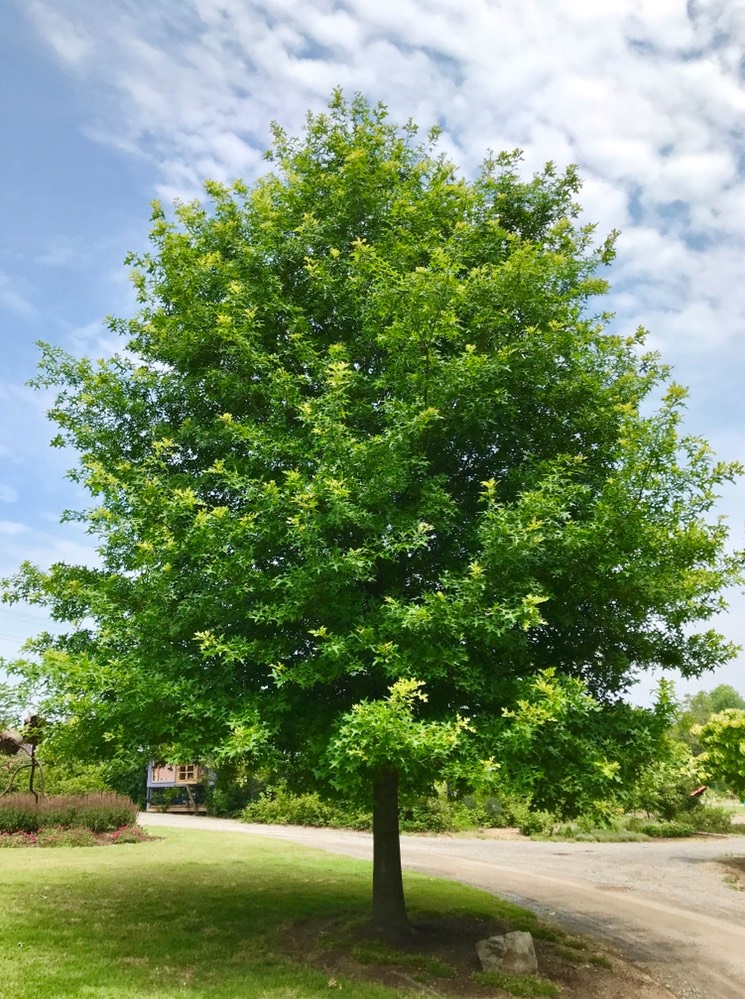
UT Gardens’ June 2019 Plant of the Month: Nuttal Oak
Submitted by James Newburn, assistant director and curator of the UT Gardens, Knoxville
People can be such creatures of habit. That characteristic often eases our lives by allowing us to take the guesswork out of our choices, but it can also stifle discovery of new things. We have meatloaf every Tuesday, take the same road to church every Sunday, and have had the same hairstyle for years. The same thing often happens in our landscapes. We want a tall, majestic shade tree. The obvious choice, easily available, and familiar to us because we see in city streetscapes, in parks, and in our neighbor’s yard is the pin oak, not to be confused with the willow oak, as these common names are often interchangeable. The pin oak in this discussion is Quercus palustris, and has a lobed leaf with sharp points, not the slender linear leaf of the “other” pin oak, also called willow oak Quercus phellos. The habit of going with the familiar, even in tree choice, can lead to a certain blandness that deprives us of discovering an unfamiliar gem.
Nuttall oak (Quercus texana, still sometimes still referred to as Q. nuttallii in the nursery trade) is an underused oak that has similar characteristics to the pin oak, but with a few bonus features. Named after the British-American botanist and ornithologist Thomas Nuttall, this oak is fast growing, with a strong central leader, with a pyramidal shape that ages to a more rounded form, making it an ideal shade tree. Native to lower Mississippi River bottomlands, this tree can tolerate poorly drained clay soils. Landscape height can reach 40 to 60 feet or more, with a spread of 25 to 40 feet —so give it plenty of room to grow in full sun. Rooting is deep, compared to shade trees like many maples, so surface roots that may damage sidewalks or water pipes are less of a problem.
Nuttalls are a superior choice to pin oaks in other ways too. They have not fallen victim to bacterial leaf scorch, a disease that has been decimating pin oaks. This disease causes early fall leaf browning, progressive defoliation and is ultimately fatal. Nuttall is a good choice as a replacement for trees that succumb to this disease.
Another endearing quality is that the lowest branches of Nuttalls stay perpendicular to the ground rather than drooping, so go ahead and put your picnic table under the branches because you’ll be able to walk (or mow) under them.
Leaf color is far more striking in Nuttall oak than many other oaks. Starting in the spring, new growth has a purple-copper color that matures to deep green. Its late fall color is yellow-orange to orange-red and may even turn brilliant red. As winter approaches it drops its leaves cleanly. Pin oak leaves are noted for their habit of hanging on, tattered and brown, well into the winter months.
Nuttall oaks may not be as widely known as pin oaks, but they are available commercially. More and more nurseries are carrying them because they are such relatively fast growing trees. The straight species is available as well as cultivars like ‘Arcade’, ‘Esplanade’ and ‘Sangria’ that vary somewhat in fall color and growth habit.
So try fish tacos next Tuesday, take the road less traveled on Sunday and dare to have a new ‘do. While you’re at it diversify your plant palette like you diversify your financial portfolio. A good place to start might just be with a Nuttall oak.
The UT Gardens includes plant collections located in Knoxville, Jackson and Crossville. Designated as the official botanical garden for the State of Tennessee, the collections are part of the University of Tennessee Institute of Agriculture. The Gardens’ mission is to foster appreciation, education and stewardship of plants through garden displays, educational programs and research trials. The Gardens are open during all seasons and free to the public. For more information, see the Gardens website: ag.tennessee.edu/utg.